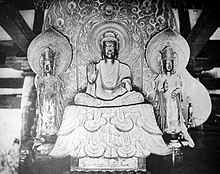Kuratsukuri no Tori
Kuratsukuri no Tori ( Japanese 鞍 作 止 利 / 鞍 作 鳥 ; he lived in the 7th century) was Japan's first creator of Buddhist bronze statues.
Live and act
Tori's grandfather, Shiba Tatto , is believed to have come to Japan from mainland Asia in the first half of the 6th century and worshiped Buddhist images. It is certain that Tori's grandfather Tatto, father and aunt Tasuna Shimane with the Soga clan have worked together to Buddhism in Japan to introduce - against the resistance of Mononobe clan . Shimane is said to have been the first to become a nun, and Tasuna is also said to have taken a vow and built a temple called Sakata-dera.
Tori grew up in an emphatically Buddhist environment. He began his creative work in 605 with a gilded bronze statue of Shakyamuni for the Hōjō-ji (also Gangō-ji or Asuka-dera , construction from 588) and completed it in 609. The Empress Suiko praised the sculpture that Tori had shown her as a model. Later, when the statue was finished, it turned out that it did not fit through the door of the main hall of the temple. Tori found a way to get the statue inside without removing the door. He received the Empress's praise for it again. As a reward, Tori received the rank of Dainin, the third highest rank within the twelve ranks of the imperial court order at that time. There are doubts whether this Buddha, today in the ango-in of the Asuka-dera, is actually from tori. In any case, it is like this: the Buddha statue was badly damaged in a fire in 1196 and was subsequently repaired on a large scale. So the original appearance is not guaranteed.
The Shaka triad in Hōryū-ji is undisputedly a work by Tori. An inscription on the halo (mandorla) behind the group of three says that Shiba Kuratsukuri no obito Tori Busshi was commissioned with the work in 623, in memory of Prince Shōtoku , the first in Japan to study Buddhism intensively. The statue was commissioned by Shōtoku's wife and her sons.
The sculpture consists of the central Buddha figure, which is flanked by two Bodhisattvas , namely in the configuration "One Essence, Three Treasures " ( 一行 三尊 ikkō sanzon ). Buddha's robe flows over the pedestal, the mokakeza. The clothing of the three figures and other details lead to the Buddhist figures in the style of the Northern Wei Longmen, as they can be found in the burial niches of those grottos . - While the Longmen style suggests western areas of China, the garments and the tendency towards abstraction point to China itself. The various influences that came to Japan via Korea led to a special mix of styles.
In the Hōryū-ji small gilded bronze statues are kept, which are very similar to the triad. They can also be found among the 48 statues of Hōryū-ji now on display in the Tokyo National Museum . Since the casting method is completely the same for all figures, it is assumed that they all come from a studio of the Tori school. All are dated to the first half of the 7th century.
literature
- Tazawa, Yutaka: Kuratsukuri no Tori. In: Biographical Dictionary of Japanese Art . Kodansha International, 1981, ISBN 0-87011-488-3 .
| personal data | |
|---|---|
| SURNAME | Kuratsukuri no Tori |
| ALTERNATIVE NAMES | 鞍 作 鳥 (Japanese) |
| BRIEF DESCRIPTION | Japanese sculptor |
| DATE OF BIRTH | 6th century |
| DATE OF DEATH | 7th century |

